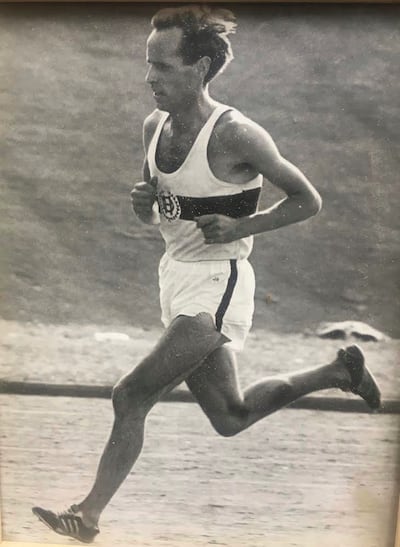In the words of Peter Byrne, the doyen of sportswriting late of this parish, it was the race which provided nearly all the excitement on the closing day of the Tailteann Games, staged on a sweltering hot Monday in Croke Park in May of 1966. And a mile record some people said might never be broken.
It will also be part of an old nostalgia trip running around Croke Park on Sunday, and aptly timed too, when at half time in the All-Ireland hurling semi-final, the GAA commemorates its athletics past and the centenary of Ireland’s first Olympic participation as the then Free State — just 17 months after it was established under the Anglo-Irish Treaty of December 1922.
Con Houlihan always said the twin ambitions in the first founding of the Gaelic Athletic Association in 1884 were to revive hurling as the national game, and to reorganise athletics, and to some extent neither ambition succeeded. There are some counties we know will never win a hurling All-Ireland, and despite establishing a new Athletics Council as part of the 1913 GAA Congress, they soon gave up completely on that cause.
Still, there are strong and lasting ties that bind, particularly with that 1924 Olympic team. Given the fact Paris also hosted those Games and are now welcoming the sporting world back 100 years later, it’s an apt celebration too, Croke Park also being one of the original playing grounds of Irish athletics.
READ MORE
To further mark those old GAA athletics links on Sunday, they’re restaging the one-mile race which headlined the last big athletics meeting in Croke Park, the Tailteann Games revival of 1966, to see if that long-standing mile record can be broken, the 4.12.1 clocked by Tom O’Riordan, my late father.
Earlier this year, the Olympic Federation of Ireland (OFI) initiated a series of centenary events, beginning with an official list of the 911 Irish names who have represented the country at the Olympics, starting in Paris in 1924, up to the delayed Tokyo Olympics in 2021.

While the credit for Ireland’s first Olympic appearance goes to the football team, who played Bulgaria on May 28th, 1924, and won 1-0 (that is also now recorded as the first international played by the Ireland football team), it happened many weeks before the official opening of the Games on July 5th, 1924.
So the athlete carrying the first Irish flag into the opening ceremony at the Stade Olympique de Colombes, in northwest Paris, was Limerick-born shot putter John O’Grady, part of the 12-man athletics team.
A day later — exactly 100 years ago today — Larry Stanley then became Ireland’s first individual Olympian when he took part in the high jump, already renowned in Kildare GAA as part of their 1919 All-Ireland winning football team.
The OFI gave the honour of Ireland’s first Olympian — as in number one of their current list of 911 — to Stanley, and last month in his home village of Caragh, they erected a monument with Stanley’s name and marking the height of 6ft 3⅛in he cleared in Croke Park when the Tailteann Games were first revived in the immediate aftermath of those 1924 Olympics.
Long before the days of the Fosbury Flop, Stanley’s feet-first scissors-kick style in Croke Park that day left him just an inch short of Harold Osborn of the USA, who won the high jump and decathlon in 1924 in Paris, considered the greatest all-round athlete of his day (you can watch it here: cutt.ly/UefRwDyx.
Stanley completed his extraordinary season a month later when winning a second All-Ireland football title, in the delayed 1923 final played in September 1924, only this time with Dublin, eligible having moved there and joining the Dublin gardaí. Also part of the 1924 Olympic team was Mayo sprinter Seán Lavan, the player credited with inventing the solo run.
Those Tailteann Games in 1924, based on the ancient event held in Tara, between 632 BC and 1168, were also the first big international event to take place in the newly established Free State.

Part of the motivation behind the last revival of the Tailteann Games in 1966 was to help unite the then “split” in Irish athletics between the rival governing bodies, the NACA, and the AAUE. To add further prestige, they were opened by Bob Tisdall, the 1932 Olympic champion in the 400m hurdles, back in Croke Park for the first time in 34 years.
Truth is, our dad never had much time for nostalgia, and certainly never spoke very often, if at all, about his mile run in Croke Park that afternoon in 1966, same as other any record he set, or indeed medal or trophy he won.
Indeed Byrne also wrote of the mile race that day: “A better approximation of O’Riordan’s figures would be four minutes six seconds, however, the five-lap grass circuit, coupled with the blazing sun, contrived to put competitors at a distinct disadvantage.
“Weigh in the fact the Donore man had nearly 60 yards to spare when winning from Paul Lavelle (Crusaders) and Jim Buckley (St Finbarr’s, Cork), and one can readily appreciate his satisfaction when the times were announced.”
It was also well short of his then mile best of 4.04.3 set in 1963, it also being his first race since running the 5,000m at the Tokyo Olympics in October 1964, having missed the entire 1965 season with injury.
Long before the days of super spikes and wave-light pacing, maybe it’s a time worthy of its status, even if it hasn’t been challenged once in Croke Park in all the years since.
That chance now comes around at half-time on Sunday, while Limerick and Cork pause for breath. Several of Ireland’s top milers have agreed to race the five-lap circuit, carefully measured in advance and laid out around cones, not too unlike it was in 1966.
Among those runners called in are Seán Tobin and Shane Bracken, who have both run a sub-four minute mile in recent years, thus also presenting them with the chance to write their own little piece of GAA athletics history, and set a mile record in Croke Park which may never be broken.

















